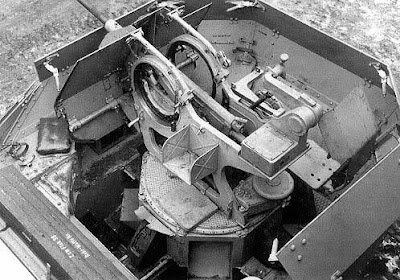20 mm Flakpanzer auf Fahrgestell Panzer 38(t) SdKfz 140 “Gepard”
A la espera de que se completase el desarrollo que usaba el chasis del PzKpfw IV se optó por desarrollar otro modelo de forma interina a partir de 1943 utilizando el chasis del PzKpfw 38(t). Este vehículo de origen checo había demostrado ser fiable y robusto y representaba una opción clara e interesante siendo utilizado el bastidor de los modelos Ausf L y Ausf M
El arma escogida fue de nuevo el Flak 38 de 20 mm, un cañón ligero que además podía ser usado para batir blancos terrestres poco protegidos montándose en la parte trasera del chasis. A la larga el Flak 38 de 20 mm demostró carecer de potencia de fuego pero a la espera de que saliesen de las cadenas de montaje nuevos vehículo antiaéreos con cañones más pesados continuó siendo válido, el vehículo podía almacenar hasta 1.040 proyectiles.
En total se solicitaron 152 vehículos que estarían en servicio hasta el final de la contienda. Sin embargo debido a la falta de potencia del arma solo se transformaron 141 bastidores del PzKpfw 38(t) producidos por BMM (Praga/CKD) mientras que los 11 restantes se utilizaron para el montaje de artillería autopropulsada “Grille”. Los primeros 87 vehículos llegaron a las unidades del frente en enero de 1944 distribuyéndose entre los pelotones de antiaéreos (Flugabwehrzug) sobre todo entre las divisiones Panzer y Panzergranaderos, principalmente de las SS como la 12 SS Panzerdivision “Hitlerjugend” en Normandia. Las pérdidas en vehículo antiaéreos fue en aumento y para el 1 de diciembre de 1944 ya solo quedaban 9 vehículos de este tipo en servicio.
Detalle del montaje del Flak 38 de 20 mm
English version
Pending that development was completed which used the chassis of the PzKpfw IV was decided to develop another model on an interim basis from 1943 using the chassis of the PzKpfw 38 (t). This vehicle of Czech origin proved to be reliable and robust and represents a clear and interesting option to be used on rack models Ausf Ausf L and M
The weapon of choice was again the Flak 38 20 mm, a light gun also could be used to beat lightly protected ground targets mounted on the rear of the chassis. Eventually the 20 mm Flak 38 was devoid of firepower but waiting to depart from the new vehicle assembly lines heavier anti-aircraft guns continued to be valid, the vehicle could hold up to 1040 rounds.
A total of 152 vehicles requested would be in service until the end of the war. However due to lack of power of the weapon only became the racks 141 PzKpfw 38 (t) produced by BMM (Praga/CKD) while the remaining 11 were used for the assembly of self-propelled artillery "Grille." The first 87 vehicles arrived to the frontline units distributed in January 1944 between the firing anti-aircraft (Flugabwehrzug) especially between Panzer and Panzergrenadier divisions, mainly from the 12th SS Panzer Division SS "Hitler Youth" in Normandy. Losses in car bomb was on the rise and the December 1, 1944 and there were only nine such vehicles in service.







Hubo otra variante del Flakpanzer 38(t) armada con el cañon MK 103 Jaboschreck de 30 mm,pero no se cuantos se fabricaron,tal vez una docena mas o menos,basandose en el Munitionspanzer 38.
ResponderEliminarhttp://imageshack.us/photo/my-images/262/1945wrecks9fc1.jpg/